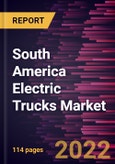The rising concern regarding the transportation sector's impact on the environment has led to an unprecedented global requirement of decarbonizing transportation to meet climate goals and limit global warming, thereby increasing the adoption of low-carbon technology in the transportation sector. Rising concerns about the adverse impact of transportation-related emissions and the shift of consumer behavior toward zero-emission vehicles have resulted in a significant increase in the adoption of light-duty passenger vehicles across the region.
Additionally, the constantly rising demand for EVs is fueled by huge investments made by automotive giants in the research & development, and production of electric vehicles. For instance, General Motors, Volkswagen, Volvo, BMW, Nissan, and Audi have collectively invested approximately US$ 150 billion in manufacturing electric vehicles and launched new models throughout 2020-2021.
Furthermore, with the fall in prices of EVs and the availability of a greater number of models, electric vehicle production is set for exponential growth in various countries, subject to countries' overall economic growth and policy support from the government. Transportation is the primary source of pollution across the region, and heavy-duty vehicles such as trucks and buses are the major contributors to this category. The high efficiency of electric trucks over conventional diesel and natural gas vehicles is another factor expected to drive this segment's growth in the coming years.
With still in the initial growth stages, this segment is anticipated to see impressive growth with the increasing push for the electrification of the transport sector across the region. The future production of these heavy electric vehicles, such as heavy-duty trucks, depends on various factors such as improvements in fuel efficiency, energy costs, reducing emissions, declining costs of batteries, and alternative fuels. With fast-changing electric vehicle technology, advancements in batteries, and a favorable regulatory environment, the demand for electric trucks and other heavy-duty electric vehicles is anticipated to grow at an impressive rate. Therefore, with the growing production and sales of EVs, the demand for electric trucks is also increasing.
With new features and technologies, vendors can attract new customers and expand their footprints in emerging markets. This factor is likely to drive the SAM electric trucks market at a promising CAGR during the forecast period.
SAM Electric Trucks Market Segmentation
The SAM electric trucks market is segmented on the basis of propulsion type, vehicle type, range, level of automation, and country.- Based on propulsion, the market is segmented into BEV, FCV, and PHEV. The BEV segment is the dominant one in 2022 and is expected to be the fastest-growing segment during the forecast period.
- Based on vehicle type, the market is bifurcated into LCVs and medium & HCVs. The LCV segment is the dominant one in 2022 and is expected to be the fastest-growing segment during the forecast period.
- Based on range, the market is segmented into less than 200 miles and more than 200 miles. The more than 200 miles segment has emerged as the dominating one in 2022 and is expected to be the fastest-growing segment during the forecast period.
- Based on level of automation, the market is segmented into semi-autonomous and fully autonomous. The fully autonomous segment has been dominant in 2022 and is expected to be the fastest-growing segment during the forecast period.
- Based on country, the regional market is segmented into Brazil, Argentina, and the Rest of SAM.
Table of Contents
Companies Mentioned
- AB Volvo
- BYD Company Ltd.
- Daimler AG
- FAW Group Co., Ltd
- Navistar, Inc.
- PACCAR Inc.
- Proterra Inc.
- Rivian
- Scania
- Tesla, Inc.
Table Information
| Report Attribute | Details |
|---|---|
| No. of Pages | 114 |
| Published | September 2022 |
| Forecast Period | 2022 - 2028 |
| Estimated Market Value ( USD | $ 332.25 Million |
| Forecasted Market Value ( USD | $ 1118.82 Million |
| Compound Annual Growth Rate | 22.4% |
| No. of Companies Mentioned | 10 |








